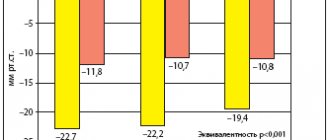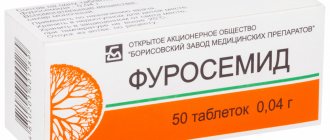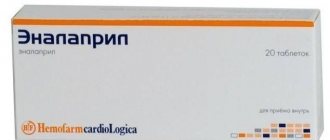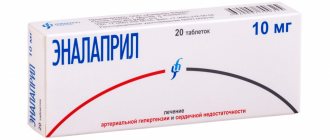Diuretics, or, as they are also called, diuretics, are a group of drugs that are not homogeneous in their chemical composition.
These drugs remove water and minerals from the human body through the kidneys. We present to your attention a list of those diuretics that are most often used in modern medicine, as well as their characteristics and classification.
Potassium-sparing diuretics
A potassium-sparing diuretic is a diuretic that regulates the release of potassium ions, minimizing their loss in urine, and also increases the secretion of sodium and chlorine in the nephrons. There are two main types of such drugs: aldosterone antagonists and distal tubular potassium excretion inhibitors. They have different mechanisms of action.
This subtype of diuretic drugs differs from classical diuretics in several factors:
- have a less pronounced effect;
- The patient does not see the effect of the medications immediately - it occurs after 10-12 hours or the next day;
- They are rarely used as separate agents for therapy; more often they are auxiliary components of complex treatment.
Which brand of diuretic is best to choose?
The first criterion by which you can choose a safe diuretic with the desired therapeutic effect is a manufacturer with an impeccable reputation, successful activities and a good range of products. Recommendations from medical specialists and real reviews helped identify worthy nominees. The following companies were included in the review:
- Kanonpharma Production (Torasemide) is a modern Russian pharmaceutical company founded in 1998. In a short period of work, a production base has already been created according to the latest innovations and international standards.
- Obolenskoye Pharmaceutical Enterprise (Spironolactone) is a Russian pharmaceutical company founded in 1994. The base of the State Center for Applied Microbiology contributed to the emergence and development. The range of modern drugs fully complies with ISO and GMP standards.
- Sopharma (Furosemide) is a private manufacturer from Bulgaria, which has been improving the quality of human life for over 80 years. In 1933, pharmacists united and created their own laboratory; since then, technologies have been regularly updated, creating natural, effective medicines.
- Quinoine Rt. (Hypothiazide) is a plant of pharmaceutical and chemical products, as well as a subsidiary of Sanofi-Synthelabo from Hungary. It has two factories, one produces products in the form of tablets and capsules, the other produces solutions for injections or in bottles.
- Gedeon Richter-Rus (Veroshpiron) is an international corporation that produces medicines in more than 100 countries. But the main office is registered in Hungary. For over 115 years, the brand has been providing clinics and their patients with high-quality, effective treatment.
- Pharmapol-Volga (Asparkam) is a Russian pharmaceutical company engaged in the production of finished medicines and substances, medical products since 1998.
- Hemofarm (Indapamide) is an international pharmaceutical company that was founded in Serbia in 1960. And since 2006, it has been privatized by the famous German company Stada Ag.
- OZONE (Hydrochlorothiazide) is one of the leading Russian companies producing medicines for various fields of medicine. Among domestic pharmaceutical companies, it stands out with its huge competitive generic portfolio.
- Ratiopharm (Amiloride) is a German company that has become famous for producing effective but inexpensive generics of world bestsellers in the pharmaceutical field. Founded in 1974. The product range is distributed not only within Germany, but also in 35 countries around the world.
- LLC Grotex (Eufillin) is a well-known Russian pharmaceutical company that produces sterile liquid medicines. All products comply with GMP standards.
- Herbapol (Phytolysin) is a Wroclaw-based herbal company offering natural treatments for various diseases. It is the largest Polish manufacturer of natural products, operating for over 60 years.
- Bionorica SE (Canephron) is a global manufacturer of exclusively herbal preparations, which has been in this business for over 80 years. Products are registered in more than 40 countries.
Indications for use
There is a list of indications when the use of potassium-sparing diuretics is justified:
- treatment of hypokalemia (used in combination with other medications);
- complex therapy of hypertension;
- diabetes mellitus of the first and second types (since with excessive urination the patient loses a lot of potassium ions);
- primary or secondary hyperaldosteronism;
- heart failure, myocardial pathology;
- gout;
- the use of cardiac glycosides (potassium-sparing agents enhance their effect);
- severe chronic swelling caused by excess sodium, chlorine or disruption of the lymphatic system.
Taking potassium-sparing diuretics is also necessary in other cases. They are prescribed when the patient, for some reason, is already taking drugs that actively remove potassium from the body, for example, carbonic anhydrase.
Mechanism of action
Diuretics that can interfere with the excretion of potassium from the body have a weak anti-edematous effect. Their point of application is the nephron tubules of the kidneys, which are responsible for potassium synthesis and sodium reabsorption. This is an active process regulated by pituitary and adrenal hormones, biologically active renin and prostaglandins secreted by the kidneys. Energy is needed for transportation and synthesis of electrolytes. This function is assigned to aldosterone.
Aldosterone intracellularly binds to the receptor protein, and then completely determines the mechanism of sodium transport, stimulating the intracellular synthesis of DNA-RNA. Ribosomes produce a new protein, “permiase,” which controls the movement of sodium through cell membranes. At the same time, aldosterone increases the enzymatic activity of tricarboxylic acids, which generate the energy necessary for sodium transport.
Potassium-sparing drugs correct electrolyte metabolism due to:
- blocking the effect of aldosterone on urination, urinary excretion inside the kidney;
- reducing tissue permeability to sodium ions.
These mechanisms can act alone or together. A sodium reabsorption of about 5% is considered normal. Diuretics reduce the indicator by a couple of units. Potassium secretion is stimulated by renin through angiotensinogen. Excess aldosterone is inactivated and removed by the liver.
Aldosterone can be synthesized reflexively when the total volume of blood circulating in the bloodstream decreases. In this case, the receptors of the right atrium, sinocarotid sinus, cranial cavity, and large pericardial veins send a signal to the hypothalamus. It synthesizes neurohumoraglomerulotropin, which stimulates the production of aldosterone, which enhances the reabsorption of sodium by the kidneys and the filling of the circulatory system with fluid. The required water balance suppresses the synthesis of aldosterone, and a reabsorption effect occurs.
There are no large fluctuations in microelements, no gross interference in the body’s activities occurs. Therefore, potassium-sparing diuretics with minimal diuretic effect, gradually reducing the load on the heart, are the drugs of choice in the treatment of cardiovascular pathology. They begin to act a couple of hours after administration, and end after 10 hours.
The most common
- Spironolactone.
This is a potassium-sparing and magnesium-sparing diuretic drug; it is an aldosterone antagonist. The active ingredient is spironolactone. Spironolactone is used individually and prescribed by a doctor. As a rule, for edema, 100 to 200 mg per day is prescribed, and this dose must be divided into 2-3 times. This dosage is prescribed for 14-21 days. The course can be repeated after 10 days.- Can be taken by pregnant women, but in the 2nd and 3rd trimester. During breastfeeding, it can also be taken, only taking into account that the active substance will pass into the milk in a minimal amount.
- The cost of Spironolactone in the form of tablets 25 mg No. 30 is 297 rubles.
A dose of 300 mg per day can be prescribed for the treatment of hyperaldosteronism and in cases where the analysis showed a reduced potassium content in plasma. The dosage is divided into 2-3 doses.
- Aldactone
This drug belongs to the potassium- and magnesium-sparing diuretics and aldosterone antagonists. The active ingredient is spironolactone. Prescribed 100-200 mg in 2-3 doses, when they are combined with other types of diuretics (loop, thiazide). An amount of 300 mg is prescribed if there is severe hyperaldosteronism, as well as with a decrease in potassium in the plasma; this dose should also be divided into 2-3 doses.
It is contraindicated to use during the 1st trimester of pregnancy; as for the 2nd and 3rd, this is possible, but only as prescribed by a doctor. It can also be used during lactation, but the active substance will pass into milk in minimal quantities.
This is a potassium-sparing diuretic, which is an aldosterone antagonist (long-acting). The effect of taking a diuretic appears on days 2-5 of therapy. The active ingredient is spironolactone.
Prescribed for essential hypertension from 50 to 100 mg per day, taken once. For hyperaldosteronism, 100 to 400 mg can be prescribed, depending on individual characteristics. If edema appears in chronic heart failure, 100 to 200 mg per day is prescribed, and the drug is combined with other types of diuretics.
Triampur is a combination diuretic, that is, it contains triamterene (a potassium-sparing substance) and hydrochlorothiazide (a thiazide diuretic). It is prescribed for arterial hypertension 2 times, 2 tablets, but if the treatment is long-term, then 2 tablets are prescribed per day. The initial dose for edema is 1 to 2 tablets 2 times. Maintenance therapy is also prescribed, the dosage is 1 tablet per day or 2 tablets every other day. For complex treatment of heart failure, 2 tablets per day can be prescribed, the maximum dose is 4 tablets. But the individual testimony of the patient is quite important.
If renal failure develops, it is not recommended to take more than 1 tablet per day. It is prohibited to take the drug during pregnancy and lactation. If necessary, stop feeding.
Author of the article:
Elena Demidova
about the author
Did you like the article?
Let us know about it -
rate
Pharmacokinetics
Diuretics that prevent the intensive excretion of potassium have pharmacokinetics that are optimal for the human body. They are taken after meals, once or twice a day, so they are well absorbed by the digestive system, almost completely enter the bloodstream, where up to 80% form protein complexes, and undergo maximum biotransformation by the liver. In this case, they are excreted unchanged by the kidneys.
Dosage matters. Long-term use of potassium-sparing diuretics can provoke hyperkalemia. Therefore, if a patient who is planning to prescribe such drugs has already been diagnosed with high blood potassium levels, sodium channel blockers and aldosterone antagonists are contraindicated.
Diuretics vary in the speed of the planned effect; they are usually used in combination with other diuretics, which allows maintaining potassium levels at a level of 3.4 to 5.3 mmol/l.
There are fast-acting, slow-acting, hormonal, and non-hormonal diuretics.
Sodium channel blockers
These are fast hormonal diuretics. They are used to relieve edema of the heart and liver, and correct blood pressure with significant doses. Representatives of this group of potassium-sparing diuretics are:
| Name | Properties |
| Amiloride | Pyrosinoylguanidine derivative: stimulates the intensity of the excretion of sodium and chlorine ions, reduces the excretion of potassium ions from the human body |
| Triamterene | Reduces the permeability of cell membranes to sodium, increases its excretion in the urine without stimulating the release of potassium. Reduces distal secretion, enhancing the diuretic effect of thiazides, the effect appears after 15 minutes, the maximum is recorded after a couple of hours, duration of effect is 12 hours |
| Triamtezid | Combined potassium-sparing diuretic, has a diuretic, hypotensive effect, increases the urinary excretion of sodium, chlorine, water, bicarbonate, practically without affecting the excretion of potassium, magnesium, the effect is noticeable after a couple of hours, duration up to 10 hours |
It is necessary to distinguish between diuretics that block sodium channels and antiarrhythmic drugs that act in the same way. They work on the membranes of cardiomyocytes, reducing the rate of myocardial depolarization, achieving normalization of heart rhythm (Novocainamide, Allapinin, Aymalin).
Aldosterone antagonists
Hormonal potassium-sparing agents do not affect aldosterone, so they can be prescribed for the treatment of diseases associated with hyper- or hypoaldosteronemia: Conn's syndrome, for example, with a tumor of the adrenal cortex. The speed of action of individual representatives is different:
| Titles | Properties |
| Spironolactone | Removes sodium and chlorine from the body, while simultaneously accumulating magnesium, potassium, calcium, prescribed even to pregnant women from the second trimester, but not recommended during lactation due to the risk of the drug getting into milk, taken three times, 60-70 mg, in courses of three weeks with a ten-day break |
| Eplerenone | The mechanism of action is similar to Spironolactone, but affects cholesterol levels, increasing it, prohibited during pregnancy |
| Triamtezid | One of the lightest diuretics that does not remove potassium is used in the complex therapy of arterial hypertension. |
| Aldactone | Relevant for diagnosed severe aldosteronism, not recommended for pregnant and lactating women |
| Veroshpiron | A derivative of spironolactone, used for edema of cardiac origin, the dose should not exceed 300 mg/day, contraindicated in pregnant women, during lactation |
Side effects
Although this group of diuretics is inferior in potency to “classical” diuretics, in large doses or with long-term use they can give unwanted side effects:
If such symptoms and conditions occur, the patient should stop taking the diuretic and consult a doctor. If the patient needs to constantly drink diuretics, the specialist will select a different type of drug. When there is no urgent need for this, they take a break from therapy.
List of European drugs, Russian analogues
In the European Union, diuretics are found in pure form and in addition to thiazides. The first group includes original drugs, generics (analogues produced under license):
| Original | Analogue |
| Aldactone | Spironolactone |
| Dyrenium | Triamtren |
| Inspra | Eplerenone |
| Midamor | Amiloride |
In the second, combinatorial with thiazides:
- Aldactazide is an analogue of an antihypertensive drug combined with Spironolactone;
- Dyazide is a generic drug that lowers blood pressure with Triamterene;
- Maxzide – a copy of Triamtezide;
- Moduretic - a copy with the antihypertensive Amiloride.
All drugs can be purchased in pharmacies in the Russian Federation.
Russian analogues are produced based on the active substance - spironolactone, these are:
- Aldactone;
- Veroshpiron;
- Spirix;
- Spironoxane;
- Spironol;
- Unilan.
In addition, drugs are used - derivatives of amiloride, triamterene, eplerenone.
Contraindications
Most people are able to take potassium-sparing diuretics. However, there are certain contraindications to taking these drugs, namely:
- High levels of potassium in the blood (hyperkalemia);
- Renal damage, renal failure (increases the risk of developing hyperkalemia);
- It is undesirable to combine them with ACE inhibitors in elderly patients (read more about the reasons in the section other diuretics below);
- Addison's disease.
Thiazide diuretics in the treatment of arterial hypertension
In June 2007, at the European Congress on Hypertension in Milan (Italy), new European guidelines for the treatment of arterial hypertension (HTN) were announced. Particular attention of cardiologists was directed to the place of certain classes of drugs in treatment regimens for hypertension.
6 rational combinations of antihypertensive drugs have been proposed [1]:
- thiazide diuretic + angiotensin-converting enzyme (ACE) inhibitor;
- thiazide diuretic + angiotensin receptor blocker;
- calcium antagonist + ACE inhibitor;
- calcium antagonist + angiotensin receptor blocker;
- calcium antagonist + thiazide diuretic;
- beta blocker + dihydropyridine calcium antagonist.
Based on the above, we can conclude that calcium antagonists (4 times) and thiazide diuretics (3 times) appear most often in combinations.
Thiazide diuretics have long been used as agents for the treatment of hypertension. In the 2007 European guidelines, the target groups for whom diuretics are preferred include elderly patients with systolic hypertension as well as heart failure [1].
However, the use of medium and high doses of thiazide diuretics is currently considered undesirable: for example, hydrochlorothiazide at a dose of 100 mg/day increases the risk of sudden death, and at doses of 50–100 mg/day does not prevent the development of coronary heart disease (CHD). In this regard, the recommended doses of thiazide diuretics are currently 12.5–25 mg/day, which do not always achieve an adequate diuretic and antihypertensive effect [2]. In addition, limiting the doses of thiazide diuretics is also associated with their negative effect on carbohydrate, fat and purine metabolism [3]. Therefore, in the 2007 European recommendations, gout was included as absolute contraindications to the use of thiazide diuretics, and metabolic syndrome and impaired glucose tolerance were included as relative contraindications. In addition, special emphasis is placed on the fact that high doses of diuretics cannot be prescribed to pregnant women due to the possibility of reducing circulating blood volume (CBV) and deteriorating blood supply to the fetus. However, we should not forget that diuretics can delay the development of chronic heart failure in patients with hypertension (Davis BR, 2006).
Thus, it is obvious that the scope of application of thiazide diuretics in the treatment of hypertension is quite limited. In this regard, the thiazide-like diuretic indapamide is of particular interest.
Indapamide has a dual effect, due to which it has a short-term and long-term antihypertensive effect. The short-term effect is associated with the effect of the drug on the proximal part of the distal tubules of the nephron and represents a natriuretic effect characteristic of representatives of the diuretic class as a whole. As for the long-term antihypertensive effect, it is unique to indapamide and occurs due to a direct vasodilating effect on the smooth muscle cells of the vascular wall [4].
The antihypertensive effect of indapamide retard 1.5 mg was compared with amlodipine (5 mg/day) and hydrochlorothiazide (25 mg/day) in a study of 605 patients with hypertension treated with the above drugs for 3 months. The number of patients responding to monotherapy was slightly higher in the indapamide-retard group (75.3%) compared with the amlodipine (66.9%) and hydrochlorothiazide (67.3%) groups. In the subgroup of patients with isolated systolic hypertension, a similar trend was observed: the number of respondents in the indapamide-retard group was 84.2%, while in the amlodipine group - 80%, hydrochlorothiazide - 71.4% [5].
The multicenter LIVE (Left ventricle hypertrophy: Indapamide Versus Enalapril) study examined the effect of indapamide and enalapril therapy on regression of left ventricular myocardial mass (LVMM). 505 patients (255 - indapamide group; 250 - enalapril group) with mild and moderate hypertension were prescribed indapamide retard 1.5 mg/day or enalapril at a dose of 20 mg once a day for 1 year. Therapy with indapamide led to a significant decrease in LVMM (p < 0.001); similar results were not obtained in the enalapril group. Indapamide also reduced the severity of left ventricular hypertrophy (LVH) to a greater extent than enalapril (p < 0.049) [6, 7].
Thiazide diuretics have been prescribed in combination with ACE inhibitors for a very long time: many pharmaceutical companies have even developed fixed combinations of these components. In a large number of studies, the combination of indapamide with perindopril also showed good results. However, there are not many studies on the effectiveness of combinations of indapamide with other classes of the drug.
In this regard, we found the work of Hashimoto J. et al interesting. [8], who added indapamide at a dose of 1 mg to 76 patients receiving ACE inhibitors, angiotensin receptor blockers, and calcium antagonists as monotherapy, but failed to achieve target blood pressure (BP) values with this treatment. During 4 weeks of combination therapy in these three groups, the dynamics of the level of 24-hour blood pressure monitoring, home blood pressure measurements, and random blood pressure measurements were assessed. In all groups, a significant decrease in systolic blood pressure (SBP) and diastolic blood pressure (DBP) was noted. The decrease in SBP in the evening and pulse blood pressure was significantly more pronounced in the angiotensin receptor blocker + indapamide group compared to the calcium antagonist + indapamide group. Thus, the addition of indapamide to antihypertensive therapy led to an additional hypotensive effect that lasted 24 hours.
Until recently, only three classes of drugs were thought to have nephroprotective effects: ACE inhibitors, angiotensin receptor blockers, and calcium antagonists (mainly phenylalkylamines). The nephroprotective effect of thiazide-like diuretics was demonstrated in the NESTOR study [9]. In 570 patients with hypertension and type 2 diabetes mellitus, a comparative study of the effect of indapamide retard 1.5 mg and enalapril 10 mg on the severity of microalbuminuria (MAU) was carried out during one-year therapy. There was a decrease in MAU by 37% in the enalapril group and by 45% in the indapamide-retard group. Thus, the nephroprotective effect of indapamide retard 1.5 mg turned out to be comparable and even slightly higher than that of enalapril.
Another study examined the effect of indapamide retard at a dose of 1.5 mg prescribed for 3 months, compared with placebo, on 24-hour blood pressure monitoring, carbohydrate and lipid metabolism in patients with type 2 diabetes mellitus [10]. A significant decrease in average daily blood pressure was detected in the indapamide group compared to placebo. In addition, there was no effect of the therapy on electrolytes, creatinine, lipid spectrum, uric acid, liver transaminases, insulin levels, glycosylated hemoglobin and glucose tolerance test results.
Considering that diuretics have long established themselves as the drug of choice for the treatment of elderly patients, especially those with isolated systolic hypertension (ISAH). The multicenter X-CELLENT study included 1,758 patients with systolic-diastolic hypertension or ISAH, who were then randomized into 4 groups, which received monotherapy with indapamide retard 1.5 mg/day, amlodipine 5 mg/day, candesartan cilexetil 8 mg/day and placebo for 3 months. Compared to the placebo group, a significant decrease in blood pressure was noted in all groups. The advantage of indapamide in patients with ISAH was the virtually no effect of the drug on normal DBP values while reducing SBP; the remaining drugs reduced both SBP and DBP. In addition, in this group of patients, indapamide retard reduced average daily SBP to a greater extent than amlodipine. All three types of therapy were well tolerated [11].
As we indicated above, a dose of hydrochlorothiazide of 12.5–25 mg/day is considered metabolically neutral. In the work of A. A. Semenkin et al. A comparative study of the antihypertensive effectiveness and metabolic effects of indapamide retard (1.5 mg/day) and hydrochlorothiazide (25 mg/day) was conducted. Despite the comparable antihypertensive effect, in the group of patients receiving hydrochlorothiazide, after 3 months there was a significant increase in triglyceride levels by 15.3% (p < 0.05) and glucose by 12.2% (p < 0.05), and also a significant deterioration in endothelium-dependent vasodilation by 17% (p < 0.05) [12].
Of interest is the potential expansion of indications for the use of indapamide, in particular, its use in the treatment of chronic heart failure accompanied by edema syndrome. In one recent study in patients with persistent peripheral edema, indapamide 2 mg was added to furosemide (40–120 mg/day), which resulted in a significantly greater diuretic effect without a significant effect on plasma potassium and creatinine levels [13].
Thus, the original indapamide has more than convincingly proven its antihypertensive effectiveness and organoprotective properties during research. In an attempt to combine low cost with high quality of the drug to provide the majority of patients with hypertension with drugs of adequate action, modern generics of indapamide and, in particular, the drug “Ravel SR”, produced in a dose of 1.5 mg, are of particular interest. The drug has successfully proven itself after a trial in Slovenia in 2005–2006. study [4], which examined its antihypertensive efficacy and tolerability. The drug was prescribed to 1419 patients (58.1% women, mean age 61.9 ± 11.6 years), who showed a decrease in SBP by 14.1% and DBP by 11.1%. The development of adverse events while taking Ravel SR was noted in only 2.5% of patients (the most common were dry mouth and dizziness - 0.42% each, and 1 patient required correction of potassium levels due to the development of hypokalemia without discontinuation of the drug) .
The effectiveness and tolerability of Ravel SR was also studied in domestic studies. S. V. Nedogoda et al. [14] compared therapy with Ravel SR 1.5 mg/day and hydrochlorothiazide 25 mg in patients with hypertension and obesity. Patients of the 1st group received Ravel SR for 6 months, patients of the 2nd group were prescribed hydrochlorothiazide at a dose of 25 mg/day for the first 3 months, and then they were transferred to Ravel SR (3 months). The results of the study showed that while taking Ravel SR, achieving target blood pressure values occurred 15% more often than with hydrochlorothiazide. It was noted that only on therapy with Ravel SR there was an improvement in vascular elasticity (as assessed by pulse wave velocity) and a decrease in myocardial hypertrophy, as well as an improvement in carbohydrate and lipid metabolism.
Also of interest are the results of the BOLERO program (Basic treatment and antihypertensive effect: the drug “Ravel SR” in patients with arterial hypertension), aimed at studying the antihypertensive effectiveness of the slow-release form of the drug and its effect on quality of life. It was shown that the use of indapamide retard for 2 months led to a decrease in SBP and DBP in men by 18%, and in women by 15%. During treatment, cardiovascular risk decreased to the same extent in men and women, and the improvement in quality of life was more noticeable in the group of women [15].
The emergence of each new high-quality and safe generic drug is a step towards ensuring that Russian patients demonstrate higher adherence to hypertension treatment. Currently, patients with hypertension in the Russian Federation who have a target blood pressure level do not exceed 5–15% of the population, while in Western Europe there are more than 30% of such patients. The drug "Ravel SR" (indapamide retard) 1.5 mg as an antihypertensive drug with a mild diuretic effect has every opportunity to expand the boundaries of the use of diuretics outlined by modern recommendations for the treatment of hypertension.
For questions regarding literature, please contact the editor.
D. A. Napalkov , Candidate of Medical Sciences MMA named after. I. M. Sechenova , Moscow
Types of potassium-sparing drugs
Diuretics that conserve potassium in the body are divided into two types:
- competitive aldosterone receptor antagonists;
- inhibitors of tubular secretion of potassium ions in the distal tubules of nephrons.
The first group of drugs has a competitive mechanism of action. The main substance of the drug has a similar molecular structure to aldosterone, a hormone that enhances the reabsorption of sodium. This is necessary to reduce salt loss and raise blood pressure. The antagonist agent binds to aldosterone receptors, blocking them, and the real biologically active molecule can no longer bind to them. The body begins to excrete more sodium, and the body retains potassium and calcium.
Competitive aldosterone antagonists should not be taken for too long, as they reduce sensitivity to the hormone, and this can disrupt mineral metabolism.
Diuretics of another generation - inhibitors of tubular secretion of potassium in the distal tubules - produce an effect by acting on the body in a slightly different way. They regulate the functioning of the sodium-potassium pump, enhancing the reuptake of molecules of the second element.
Separately, it is worth saying that aldosterone antagonists are used not only for their diuretic effect. They are often prescribed for increased secretion of mineralcorticoid in the adrenal cortex. In such cases, the patient’s body is less able to remove excess water molecules, and this negatively affects the functioning of the kidneys and heart and increases swelling, especially in the lower extremities.
The best diuretics
The formation of edema can be triggered by various diseases that affect the kidneys, heart, lungs, liver, blood vessels; it can also be the consequences of allergic reactions, pregnancy, excessive consumption of water and other abnormalities. The best diuretics, selected by Top experts based on doctors’ recommendations, patient reviews, and clinical trials, can quickly and effectively solve the problem. How to choose which of those offered to buy will be determined by the correct criteria, the reputation of the pharmaceutical company of the manufacturer, as well as the proposed circumstances requiring the use of such drugs.
Indications (general)
The reasons for using diuretics of this type are different. You need to proceed from the description in the annotation. If you imagine an average list, you get the following picture.
- Arterial hypertension, regardless of the stage of development of the disease. Also a symptomatic increase in blood pressure.
Diuretics are not prescribed in isolation. Only in a system with others, because the effect is insufficient even in large dosages.
In parallel, other diuretics and drugs are prescribed to normalize tonometer readings: calcium antagonists, beta blockers, ACE inhibitors and others.
Attention:
Renal forms of hypertension (eg renovascular) are not treated with potassium-sparing diuretics.
- Edema. Including as the main remedy for symptom relief.
- Nephrotic syndrome.
- Cirrhosis of the liver. Especially with ascites (fluid accumulation in the abdominal cavity).
- Other conditions in which the concentration of aldosterone increases.
- Insufficient amount of potassium or magnesium in the body. Both taken place and as part of prevention while taking other diuretics.
- In some cases, potassium-sparing drugs based on spironolactone can be used in the diagnosis of excessive aldosterone concentrations.
The list is approximate. It is necessary to evaluate the reasons provided by the manufacturer.










